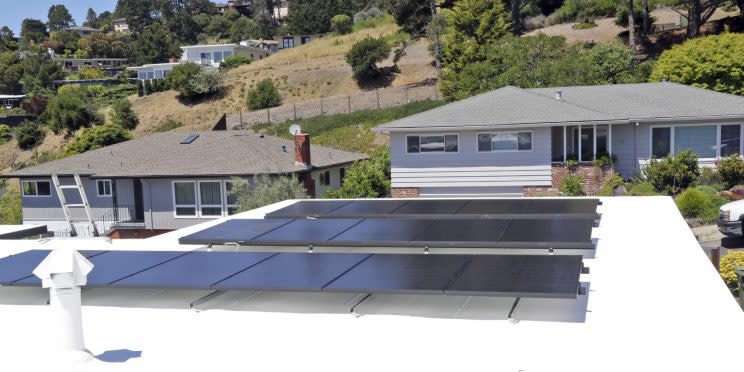How much does it cost to install solar panels on your home?

While solar energy remains a small source of Canada’s power generation, a growing amount of people are going green and installing panels on their homes.
The proposition of adding such a system may seem daunting – and expensive – but there are a number of ways for consumers to get their money back.
Sean Flanagan — owner and technician at the Ontario-based Flanagan and Sun – estimated that the cost of installing a 10-kilowatt system, the most common capacity, on an average-sized home would range from $25,000 to $30,000.
However, there is the potential for added costs if the home has a shingled roof. If it is beginning to deteriorate, Flanagan advised that homeowners should have it replaced so the panels will not need to be taken down and remounted.
“If you have a metal roof, that’s not a concern. Or if your shingles are fairly new — then they should be OK,” he said.
“But if the shingles start to get a bit older then (homeowners will) either have to be prepared to spend few thousand more or just get the roof redone before they get solar.”
Ends up ‘paying for itself’
While this may seem like a steep price to pay, Flanagan said that it is an investment that ends up “paying for itself.”
Currently, the best way for consumers to make money back on their solar panel systems is through feed-in tariff programs that are available in New Brunswick, Nova Scotia, Prince Edward Island, British Columbia and Ontario – where more than 99 per cent of the country’s solar electricity is generated.
Feed-in tariffs, or FIT, are agreements between governments, local producers and electricity utilities that allow users to lock in for payments in exchange for the energy they feed into the power grid.
Such a program has existed in Ontario since 2009. It has allowed homeowners and businesses to receive fixed prices for the electricity they generate over the span of 20 years.
In particular, the MicroFIT stream of the program, which applied to systems of 10 kW or less, initially at the rate of 80.2 cents per kWh, has been a boon for consumers.
While this is the last year the Ontario government is accepting applications as the program is coming to an end, homeowners can still ink a 20-year contract at 28.8 cents per kWh.
At this rate, Flanagan said consumers could earn about $3,100 a year and recoup their capital expenditures after nine years.
“It takes half the period to pay it off and the remaining time you’d just be making money off it,” he said.
MicroFIT users would also be able to claim the income if they register for an HST number and get a rebate for the taxes
However, Flanagan said the $3,100 figure would only apply to roofs with the ideal conditions. In particular, roofs need to be south-facing and have no shade.
“Shading is a real killer,” he said.
“Quite often I’ll go to places who want to do solar and I have to tell them it doesn’t make any sense because they have too many trees, there’s a building in the way, or they’ll have dormer on their house and the dormer will shade the roof.”
Net metering
The next best option for consumers to offset their solar panel costs is net metering.
Through this process, homeowners can obtain a credit towards their electricity bill if they produce more power than they consume. Every province has implemented a net-metering plan, with Newfoundland and Labrador being the last to do so in May.
In Ontario, this credit can be carried forward for up to 12 months, according to the Flanagan.
By Flanagan’s estimation, net metering in Ontario is worth about 14 cents per kWh, based on the cost of electricity.
This means homeowners who install solar panels when MicroFIT is no longer available will need 18 years for the system to pay for itself.
“Unfortunately, after this year it’s going to be the only game in town,” said Flanagan.
Tesla roofs?
But what about consumers who are eyeing the highly anticipated solar roofs from Tesla, which are slated to become available in Canada next year?
While CEO Elon Musk has indicated that the tiles, which come with a lifetime warranty, could be cheaper than a regular roof with energy savings factored in, Flanagan said the claim is a “bit misleading.”

He said this is because Tesla is making the comparison to the costs associated with building a slate roof and the payback period is being stretched out to the lifetime of the house.
“That’s a really long payback period,” he said.
Flanagan pegged the cost of installing a roof with Tesla shingles on an average-sized home at about $80,000, with that number rising as high as $100,000 when the expenses of hooking up the system are tallied as well.
“It’s hard in my world to say that could be possibly cheaper than a traditional roof because most people put on really cheap shingle roofs, so they’re not comparing to a shingle roof, they’re comparing to some really high-end roof,” he said.
“And that’s their market. They’re going to go after people who aren’t looking to make money off their solar roof.”
The potential cost is exacerbated by the fact that for consumers in Ontario the MicroFIT program will no longer be available when the Tesla tiles come to Canada.
Many Canadians would have to offset the costs of their Tesla roof with net metering.
“They’ve got different styles and they look really neat,” said Flanagan.
“(But) that’s way out of the reach for the average person.”

 Yahoo Finance
Yahoo Finance 
